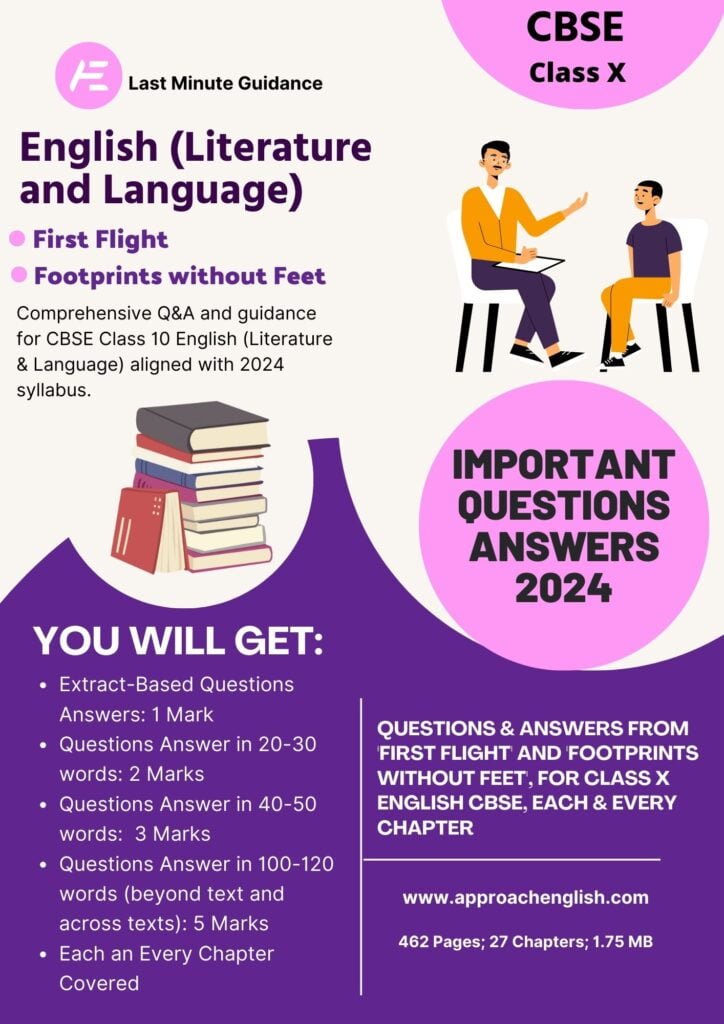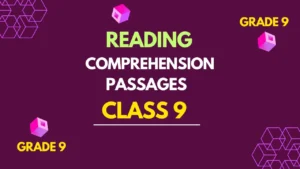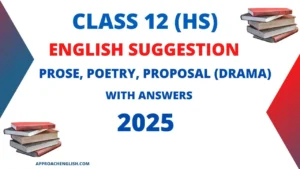Fog Class 10 Questions Answers are provided here that are going to be important for the CBSE Board Exam for class 10 students. Different types of Questions answers are arranged from the poem Fog, according to the latest NCERT recommendation.
Central Idea of Fog Class 10
In Carl Sandburg’s poem “Fog,” the central idea encapsulates the atmospheric and transformative nature of fog. Through vivid descriptions and personification, fog is portrayed as a stealthy, cat-like entity that creeps in silently, enveloping and altering the environment. It symbolizes ambiguity, obscuring clarity and blurring distinctions, much like the way uncertainty can cloak our perceptions in life. The poem captures the mysterious allure of fog, emphasizing its ability to both mystify and transform landscapes, while also alluding to the broader human experience—wherein uncertainty and ambiguity often shroud our understanding, compelling us to navigate through the veils of uncertainty and ambiguity to seek clarity.
Translation
कार्ल सैंडबर्ग की कविता “फॉग” में केंद्रीय विचार कोहरे की वायुमंडलीय और परिवर्तनकारी प्रकृति को समाहित करता है। ज्वलंत वर्णनों और मानवीकरण के माध्यम से, कोहरे को एक गुप्त, बिल्ली जैसी इकाई के रूप में चित्रित किया गया है जो चुपचाप रेंगती है, पर्यावरण को घेरती है और बदल देती है। यह अस्पष्टता, धुंधली स्पष्टता और धुंधले भेदों का प्रतीक है, ठीक उसी तरह जैसे जीवन में अनिश्चितता हमारी धारणाओं पर पर्दा डाल सकती है। कविता कोहरे के रहस्यमय आकर्षण को पकड़ती है, परिदृश्यों को रहस्यमय बनाने और बदलने की क्षमता पर जोर देती है, साथ ही व्यापक मानवीय अनुभव की ओर भी इशारा करती है – जिसमें अनिश्चितता और अस्पष्टता अक्सर हमारी समझ पर छा जाती है, जो हमें खोजने के लिए अनिश्चितता और अस्पष्टता के पर्दे के माध्यम से नेविगेट करने के लिए मजबूर करती है। स्पष्टता.
CBSE Class 10 English (Literature and Language) Questions Answers pdf 2024
Suggestive Sample Question Answers Papers pdf 2024 for Class X English (First Flight and Footprints without Feet), tailored to the 2023-24 syllabus, serve as essential preparation material for the upcoming CBSE board exam, aiding students in comprehensive understanding and practice.

Poetic Device used in Fog Class 10
Personification: The fog is personified as it’s described as coming on “little cat feet.” This personification attributes human-like qualities to the fog, specifically likening its movement to that of a stealthy cat, creating a vivid image of its quiet, gradual approach.
Metaphor: The fog is metaphorically compared to a cat, emphasizing its silent and gradual nature. This comparison enhances the readers’ understanding of how the fog moves and behaves, evoking a specific image and feeling.
Repetition: The word “fog” is repeated throughout the poem, emphasizing its presence and creating a rhythmic pattern. This repetition reinforces the central theme and creates a sense of the fog’s persistent and pervasive nature.
Imagery: Sandburg employs vivid imagery to describe the fog’s characteristics, such as its “little cat feet,” its movement coming “on silent haunches,” and how it “sits looking over harbor and city.” These visual descriptions evoke a strong sensory experience, enabling readers to visualize and feel the fog’s presence.
Translation
वैयक्तिकरण: कोहरे का वैयक्तिकरण “छोटी बिल्ली के पैरों” पर आते हुए किया गया है। यह मानवीकरण कोहरे में मानव जैसे गुणों को दर्शाता है, विशेष रूप से इसकी गति की तुलना चोरी-छिपे बिल्ली से करता है, जिससे इसके शांत, क्रमिक दृष्टिकोण की एक ज्वलंत छवि बनती है।
रूपक: कोहरे की तुलना बिल्ली से की जाती है, जो उसके शांत और क्रमिक स्वभाव पर जोर देती है। यह तुलना पाठकों की समझ को बढ़ाती है कि कोहरा कैसे चलता है और कैसे व्यवहार करता है, जिससे एक विशिष्ट छवि और भावना उत्पन्न होती है।
दोहराव: “कोहरा” शब्द पूरी कविता में दोहराया गया है, इसकी उपस्थिति पर जोर दिया गया है और एक लयबद्ध पैटर्न बनाया गया है। यह दोहराव केंद्रीय विषय को पुष्ट करता है और कोहरे की निरंतर और व्यापक प्रकृति की भावना पैदा करता है।
इमेजरी: सैंडबर्ग कोहरे की विशेषताओं का वर्णन करने के लिए ज्वलंत इमेजरी का उपयोग करता है, जैसे कि इसकी “छोटी बिल्ली के पैर”, इसकी गति “खामोश करवटों पर” होती है, और यह कैसे “बंदरगाह और शहर को देखती है।” ये दृश्य विवरण एक मजबूत संवेदी अनुभव उत्पन्न करते हैं, जो पाठकों को कोहरे की उपस्थिति की कल्पना करने और महसूस करने में सक्षम बनाते हैं।
People also ask
Q3 Fog Class 10 Questions Answers MCQ Extract Based 1
(A) The fog comes
on little cat feet.
It sits looking
over harbour and city
on silent haunches
and then moves on.
i Choose the option with qualities of the cat that Carl Sandburg applies to the fog?
1) Cats are independent animals, they don’t follow rules, they slip and slide in and out of our lives as they please.
2) Cats are distrustful of strangers and can be jealous and moody.
3) Cats are stealthy, moving in slow motion at times and they appear to be moving in a mysterious fashion.
4) Cats often communicate with a combination of a distinctive sound and body language.
5) Cats like to move on at their own pace and before you know it, they’ve disappeared.
a) Only 1
b) 2, 3 and 4
c) 1,3 and 5
d) Only 4
Ans: c) 1,3 and 5
ii Which one/s of the following applies to the given lines?
| (1) Personification is a literarydevice where you give ananimal, object or naturalphenomenon, qualities orabilities that only a humancan have. | (2) Transferred epithet is aliterary device when anadjective usually used todescribe one thing istransferred to another. | (3) Imagery is the languageusd by poets, and writersto create visualrepresentation of ideas inthe minds of the readers. | (4) Oxymoron is a figure ofspeech in whichcontradictory termsappear side by side. |
a) 1 and 4
b) 2 and 3
c) Only 1
d) Only 3
Ans: d) Only 3
iii Pick the option that includes an image of the cat on its haunches.
a. Option (1)
b. Option (2)
c. Option (3)
d. Option (4)
Ans: b. Option (2)
iv Choose the option that DOES NOT list the movement of the fog.
| (1) It stole in on us like a foot-padSomewhere out of the sea and air…-E.J.Pratt | (2) A fog drifts in, the haevy-ladenCold white ghost of the sea–Sara Teasdale | (3) The fog it tricks the eyeThe wonder of the veil of whiteUnder the clear blue sky.-K.C.Cox | (4) …comes gliding.rollingin at ground level,pressing its white featureless faceagainst…-R.H.Grenville |
a. Option (1)
b. Option (2)
c. Option (3)
d. Option (4)
Ans: c. Option (3)
v The poet has used short lines to compose the given poem. Choose the option that lists the most appropriate explanation for the same.
a. By keeping the lines short, the poet keeps the liberty in stepping away from rule, traditional form, logic, or fact, in order to produce a desired effect.
b. By keeping the lines short, the poet wants the reader to omit some parts of a sentence, which gives the reader a chance to fill the gaps while reading it out.
c. By keeping the lines short, the poet wants to introduce ambiguity or contradiction into an otherwise straightforward sentence.
d. By keeping the lines short, the poet is controlling the pace to make the reader slow down thereby reflecting the slow rolling in of the fog.
Ans: d. By keeping the lines short, the poet is controlling the pace to make the reader slow down thereby reflecting the slow rolling in of the fog.
Q10 Fog Class 10 Questions Answers in 20-30 words
i Stealth is an important aspect of fog. State any two instances from the poem “Fog” that suggest the same.
Ans: In Carl Sandburg’s poem “Fog,” the instances that suggest the stealthy nature of fog are when it comes “on little cat feet” and moves “on silent haunches.”
ii Highlight any two characteristics of fog from its description in the poem and justify your choice of characteristics briefly.
Ans: Two characteristics of fog highlighted in the poem are its quiet, stealthy movement (“on little cat feet,” “on silent haunches”) and its ability to envelop landscapes, obscuring visibility and altering perception.
iii Is the fog portrayed as a resident of the city or as an outsider? Support your answer with two such references from the poem “Fog”.
Ans: In Carl Sandburg’s poem “Fog,” the fog is portrayed more as a resident of the city than an outsider. Two references supporting this are “sits looking over harbor and city” and “comes on little cat feet.”
Q11 Fog Class 10 Questions Answers in 40-50 words
i Would you describe the role of the fog as active or passive? Support your answer with reference to the poem “Fog”.
Ans: The role of the fog in Carl Sandburg’s poem “Fog” appears passive. It is portrayed as silently moving and enveloping the city, described as “coming on little cat feet” and “sitting looking over harbor and city.” These depictions suggest a quiet and passive nature rather than an active role.
ii Why does the poet use the phrase “silent haunches”? Substantiate your answer with reference to the poem “Fog”.
Ans: The phrase “silent haunches” in Carl Sandburg’s poem “Fog” portrays the stealthy movement of the fog, likening it to a cat’s quiet and calculated approach. This comparison emphasizes the silent, gradual manner in which the fog moves, creating a vivid image of its slow, deliberate progression over the landscape.
Related Search
| A Triumph of Surgery Class 10 Questions and Answers |
| The Thief’s Story Class 10 Question and Answer |
| The Midnight Visitor Class 10 Question and Answer |
iii Comment, in detail, on the significance of the closing phrase of the poem- “moves on”.
Ans: The closing phrase “moves on” in Carl Sandburg’s poem “Fog” encapsulates the transient nature of fog. It signifies the continual and inevitable movement of the fog, suggesting that after it envelops and alters the landscape, it persists, never staying in one place for long, highlighting its ever-changing and transient essence.
Q12 Fog Class 10 Questions Answers in 100-120 words (beyond text and across texts)
i In the poem “Fog”, the poet features the fog as animated. If you had to write a similar poem for one other natural phenomenon, which animal would you use to convey the characteristics of that particular phenomena? Justify, in detail, your choice of animal corresponding to it by bringing out similarities.
Ans: If I were to write a poem featuring rain, I would choose the hummingbird as a fitting animal to convey its characteristics. Similar to rain, the hummingbird possesses swift, delicate movements. Rain, like a hummingbird, falls gently yet continuously, just as the bird flits gracefully from flower to flower. Both rain and hummingbirds bring a sense of fluidity and grace to the environment. Moreover, the hummingbird’s ability to bring life and nourishment to plants mirrors the role of rain in nurturing and sustaining life. By likening rain to a hummingbird, the poem could capture the delicate, rhythmic, and nurturing aspects of rainfall, emphasizing its gentle yet vital presence in the natural world.
ii Do you agree with the poet’s comparison of fog to a cat or do you feel some other image would have done justice to the poem? 45 Justify your answer by substantiating your claims with examples.
OR
The poet beautifully compares the fog to a cat. Choose any two animals from ‘How to Tell Wild Animals’ that do not have qualities that can be drawn out to be compared with a fog.
Ans: The poet’s comparison of fog to a cat in the poem “Fog” by Carl Sandburg is apt and evocative. The choice of a cat as an image aligns well with the characteristics and behavior attributed to fog in the poem. A cat’s stealthy, quiet movements resemble the gradual and silent approach of fog, as seen in phrases like “comes on little cat feet” and “on silent haunches.” This comparison effectively conveys the elusive, mysterious, and transformative nature of fog. While other images might evoke different qualities, such as a river’s fluidity or a spider’s web-like spread, the cat analogy adeptly captures the essence of the fog’s behavior, enhancing the reader’s understanding of its quiet, yet pervasive presence, making it a fitting and vivid comparison.
Related Search







